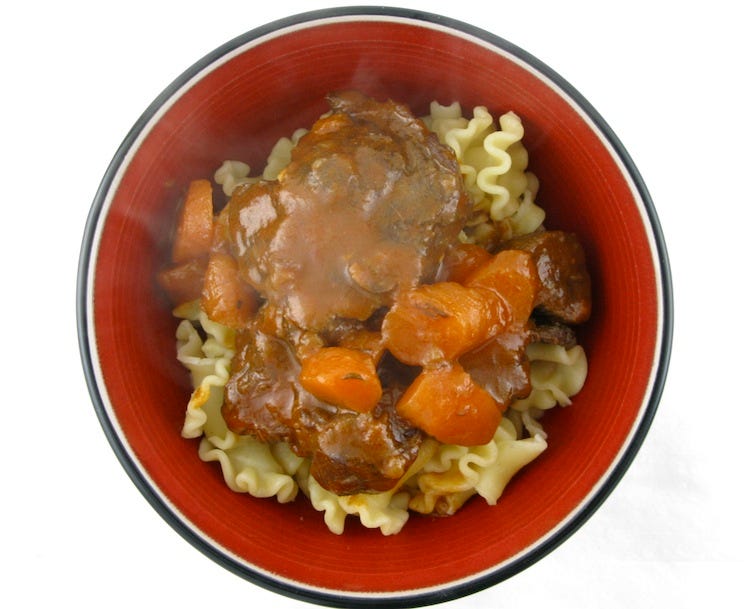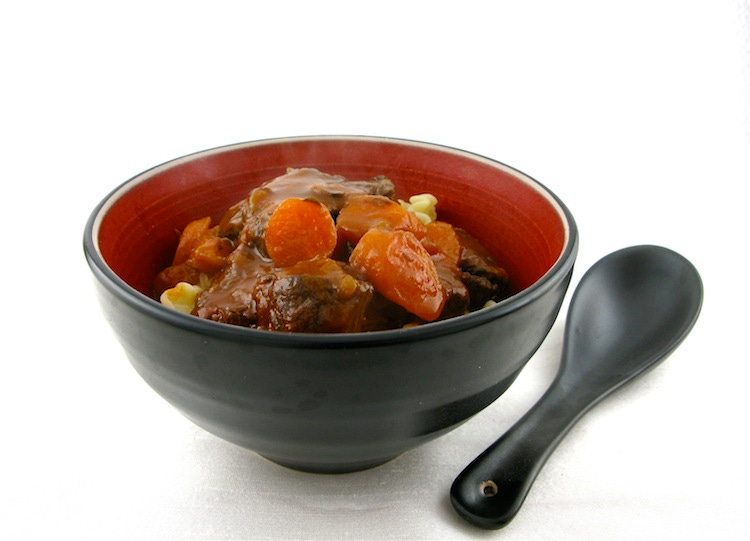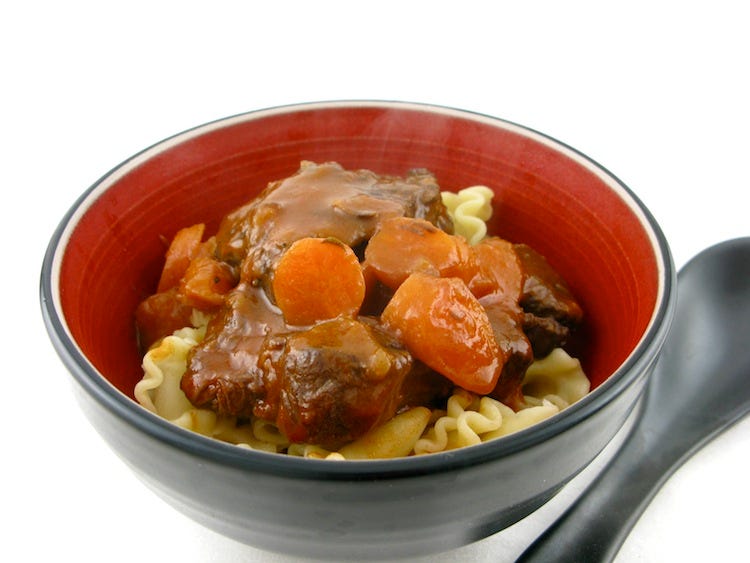Every morning the cuisinier must start again from zero, with nothing on the stove. That is what real cuisine is all about. - Fernand Point
Slow-cooked meat-based dishes have long existed in France as a way to tenderize tough or stringy cuts of meat, rendering them tender and flavorful. These dishes were made by households that either couldn’t afford the better cuts of meat that could be roasted - roasted meat was long fashionable and considered prestigious and upper class - or were made in kitchens with those lesser cuts of meat leftover from the whole animal after the better cuts were, yes, roasted. Got it?
Slow cooking soup- or stew-type dishes was also a necessary time saver; a pot could be placed on the fire early in the morning to simmer until lunch while everyone went off to work. The resulting rich, hearty stew would then satisfy after a long morning of labor and fortify the family to return for a long afternoon of work. Vegetables often came much later to these stews or soups; meat was always a prime ingredient when it could be afforded; if not, the base was usually root vegetables and bread or grains.
Over time, many of these dishes evolved into something less common, something more sophisticated, often by the new bourgeoisie, who, loath to leave behind the much-loved family dishes they ate before moving up in society, just reinvented them by the addition of better cuts of meat specifically purchased for these dishes and adding more costly ingredients, veal blanquette, for example.
Sometimes, these homely dishes were popularized by restaurants or the royal court or nobles, and they spread to more kitchens and tables - think French onion soup or madeleines.
Bœuf à la mode or bœuf mode as it is often called - or daube de bœuf or bœuf carottes, depending on one’s region, habit, or ingredients - is one of these dishes and one that I love to make and eat in the cold months. (Funny anecdote - a couple of years ago in the month of August I wrote this recipe up for The Washington Post and wanted to retest it again. I went to my local butcher and asked him for “beef to make a daube or bœuf carottes.” He looked at me aghast and said “Madame, I do not have the cut of meat for you! It is NOT the season for daube!” True story.)
The first appearance of bœuf mode in a cookbook was in 1651 in François-Pierre La Varenne’s Le nouveau cuisinier françois. It had no vegetables in it. The beef is larded, put in a pot with some stock, a bouquet garni (fresh or dried herbs) and spices, braised until the meat was “well cooked” and the liquid reduced, then served with the sauce. The recipe for daube (pièce de bœuf à la mode) in the same cookbook is pretty much the same recipe, replacing the herbs and spices with wine, often white wine. Both are similar to the better known beouf bourguignon, a specialty of the Burgundy region of France, which cooks the beef with red wine, mushrooms, and tiny pearl onions.
In 1792, the first restaurant à la carte - the first eatery that offered a menu (la carte) allowing patrons to choose individual dishes rather than offering a set menu - opened in Paris, taking the name of the restaurant’s founders, the brothers Méot, serving une bonne cuisine bourgeoise - traditional home-style bourgeois cuisine. Méot was soon taken over by Tissot who rebaptized it Le Bœuf à la Mode and elevated it into a fine dining establishment. If not immortalizing this classic dish, Restaurant du Bœuf à la mode certainly brought it into its own, coming to refer to a beef dish “cooked in the style of the house”. And although a writer for La Revue de Paris penned “Le Bœuf à la Mode….justifies its vulgar and tasteless name,” the restaurant did not close its doors until 1936. A few years later, the author Colette lamented “My walk would turn into a melancholy pilgrimage, if I allowed it to. … This famous old restaurant. Its balcony is there. The beef, well larded, the excellent sauce, its bacon, its calf’s foot, have disappeared.”
Bœuf à la mode is quite simply beef and carrots cooked long and slowly in wine - some prefer white, some regions in France demand it, I use red - seasoned with salt and pepper and a bouquet garni. I brighten the dish with tomato coulis or purée. The orange peel, a nod to my cookbook Orange Appeal, is traditionally added to the dish in the Provence region of France and adds a wonderful hint of citrus which is amazing with tomato- and wine-based sauces. I then allow the stew to slowly braise or simmer until the meat and the carrots are fork tender, the sauce thickened.
It is always suggested that one cooks a dish with the same wine one will drink with the meal and bœuf à la mode or bœuf carottes works well with a dry, fruity red “with character” such as a Chinon (of course), Zinfandel, Graves, Haut-Médoc, Morgon, Pomerol, Saumur-Champigny or similar.
This recipe requires no marinating. Buy the ingredients at the market in the morning and have the dish the same day for lunch or dinner. And, of course, a dish like this is even better the second day, allowing the flavors to meld and develop and the meat to soak in more of the flavorful sauce. Use beef cuts that benefit from long, slow cooking: boneless chuck or shoulder, or cheek, the excess fat - but not all of it - trimmed.
I make my Boeuf aux Carottes early in the morning for lunch or for dinner, counting on finishing the cooking at least an hour before the meal is served, removing it from the heat, and allowing it to rest and the flavors to develop. When you put your water for the pasta, turn the heat under the Beef and Carrots to low or medium-low to gently and slowly heat up and heat through.
If reheating any leftovers just add water to keep the sauce and meat from burning and to make sure there is plenty of sauce.
Boeuf à la Mode aux Carottes
Serves 4
6 tablespoons extra-virgin olive oil
1¾ pounds (28 ounces/800 grams) boneless beef for stew such as chuck or shoulder, excess fat trimmed, cut into 2-inch cubes
Salt and freshly ground black pepper
2 medium yellow onions, each cut into 8 wedges
3 or 4 cloves garlic, peeled and crushed
1 heaping tablespoon (about 30 grams) flour
Scant 1 cup (7 ounces) tomato purée or coulis or scant ½ cup (3 ounces/100 ml) tomato paste
Small bouquet of herbes de Provence or bouquet garni dried or fresh (thyme, rosemary, bay leaf tied with kitchen twine)
2 long, wide strips fresh or dried orange peel (without the white pith)
1 to 1½ pounds (500 to 750 grams) carrots, scrubbed well and trimmed and peeled, then cut into 1-inch chunks
One 750-milliliter bottle dry, fruity red wine
To serve:
1 lb (500 g) fresh or dried pasta, preferably something thick or shaped to help scoop up the sauce -or- about 1 – 1 ½ lbs (500 to 750 grams) fingerling potatoes
Heat 4 tablespoons of the oil in a large, heavy pot or Dutch oven over medium-high heat. Once the oil shimmers, add the meat and sear it for 2 to 3 minutes, tossing the cubes continuously, until browned on all sides. Season with a large pinch of salt and a couple of grindings of pepper.
Add the remaining 2 tablespoons of oil; when the oil is hot again, add the onions, garlic, and the flour; toss and stir until the meat is evenly coated. Cook for about 5 minutes until the onions are tender and the meat has a browned crust.
Add the tomato purée or paste, the herbs, and the orange peel, and another large pinch of salt and a few grindings of pepper. Pour in just enough of the wine to cover the meat. Stir to blend well; if using tomato paste make sure it is dissolved. Once the wine begins to boil, reduce the heat to medium-low; cover and cook for 1 ½ hours, adjusting the heat as needed so the liquid remains at a simmer, just barely bubbling.
At the end of the first 1 hour 30 minutes, add the carrots and continue to cook for another 45 minutes to 1 hour, adding water only as needed. The meat and the carrots should be beautifully tender and the wine, water, and juices should have formed a nice thick sauce. Add more water to thin out if desired. Taste and add more salt and pepper as needed and to taste.
Discard the herbs and orange peel before serving.
Serve piping hot with pasta, boiled or roasted potatoes or rice.
Or cool completely before storing.
Thank you for subscribing to my Substack, Jamie Schler’s Newsletter, where I share my (mostly French) recipes, my hotel and my jams, my projects, and the stories of my life. You can support my work by sharing the link to my Substack with your friends, family, and your social media followers. I’m so glad that you’re here.





I love the history. I started making daube just after college - I still have the crinkled old magazine page with the recipe. Will make this for the chilly, rainy week ahead. Thank you Jamie!
Making this wonderful dish for the second time in a week! Thank you!!!